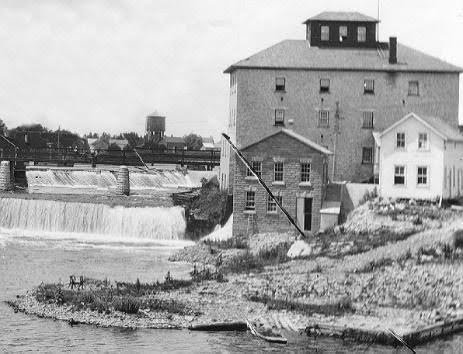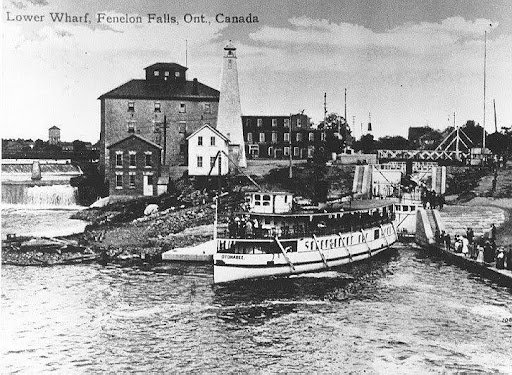Fenelon Historical Archives
The Village and the Locks
The Village of Fenelon Falls was incorporated in 1874, and after the railroad reached the community in 1876, federal lock construction took place between 1882 and 1887. A flight of two locks was needed to overcome the difference in elevation between Sturgeon Lake and Cameron Lake. This would allow for continuous navigation from Coboconk to Buckhorn, and to practically all of the Upper Lakes. The original locks were built using natural limestone blocks from the area, some weighing up to two tons. In the process of building the locks, a canal channel was cut around the falls to the north, creating a small island right in the town.
Industrial Activity and Transformation
The western sector of the Trent-Severn Waterway attracted various activities. Gristmills and manufacturing facilities were established at several sites to take advantage of plentiful water power and ease of transportation. Fenelon Falls was an important sawmilling centre for the Kawarthas. A prominent structure on the lock island was a stone gristmill built in the 1800s and powered by water from the river. The mill was used for one purpose or another until the late 1960s when it was gutted by fire and eventually torn down. Sawmills that had run on both sides of the river were replaced by municipal plants for the generation of electricity to power the bustling service centre.
Steamboats and Tourism
In 1894, the Grand Trunk Railway’s conversion of their fixed bridge at Fenelon Falls to a swing bridge meant that even steamships could travel up and down the locks. During the 1890s, steamer excursions became popular with lodges, clubs, and church groups. Many featured regattas and elaborate lantern-lit dances at island pavilions and, Fenelon Falls became better known as a destination for cottagers, recreational boaters, and tourists as lumber declined.
Here is how the Trent Valley Navigation Company, a steamboat operator, described Fenelon Falls in their 1907 brochure:
“Fenelon Falls, in the heart of which the steamer lies at her wharf, is a thriving little village of two thousand inhabitants, situated midway between Sturgeon and Cameron Lakes. It has daily connection with Toronto and other points by Grand Trunk Railway and has all the advantages of electric lights, mail, telephone and telegraph. The hotel accommodation is of the best, and there is no lack of rowboats, steamlaunches, and craft of every description at the disposal of the visitor, who will find the village a most enjoyable point at which to spend a few weeks.”
Steamboating came to an end rather abruptly for several reasons. AS roads circled the various lakes, storeowners and farmers found it cheaper and faster to send goods by land. Similarly, logging companies began to ship their logs by rail, then truck. Cottages and hotels became accessible by car and vacationers did not need steamers to take them to their destinations. At the same time, more and more people acquired their own pleasure craft and the pattern of recreational activity became more personal and less oriented to large excursions.
Modernizing the Locks
Originally two locks in flight were built at Fenelon Falls and the highway running through town crossed them on a swing bridge. Between the First and Second World Wars, lockages were operated manually by boaters.
The two locks in flight were replaced by a single modern concrete lock in 1963, The increase in overhead clearance meant that a swing bridge was no longer necessary, and the swing bridge was replaced with a fixed highway bridge.
As boat traffic increased, the two locks became an impediment to rapid through navigation. Furthermore, the necessity of holding up automobile traffic during lockages was frustrating to townspeople. Accordingly, the locks were replaced with a single lock, which opened in 1963, with the lower entrance walls of natural limestone being repaired and retained to preserve the character of the older structures and save on construction costs.
The increased overhead clearance allowed the construction of a fixed highway bridge. Several commercial establishments on the island formed by the canal and the river were bought by the government and removed to make room for a day-use park. Other buildings were removed in the `1970s.
The Lockmaster's House
In 1908, a lockmaster’s dwelling house was built at Fenelon Falls on the north side of the canal just west of Colborne Street. The handsome 1-1/2 storey home was built from a plan used for a number of lockmaster’s houses in the pre-First World War period. Although the house was sold and removed from the site in 1963, it might still be standing somewhere in the nearby community. The house would have looked very similar to the lockmaster’s house at Lock 46 – Swift Rapids, the only remaining one of this type.








